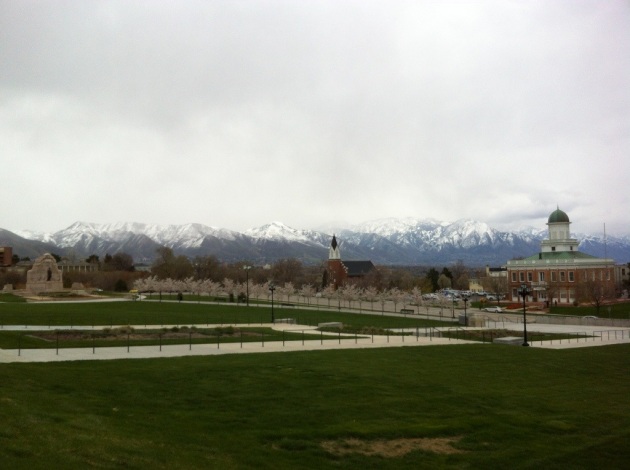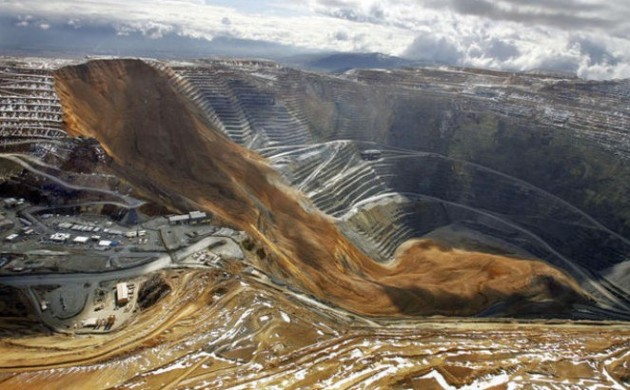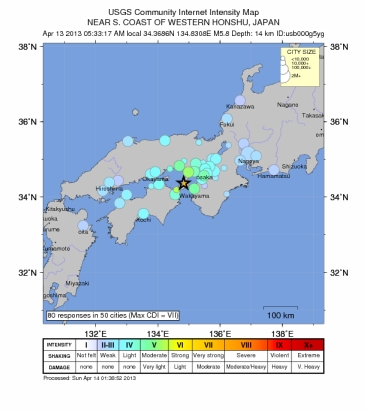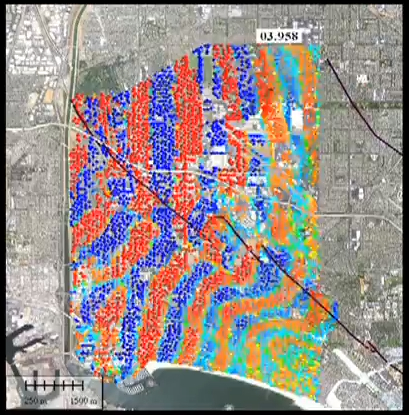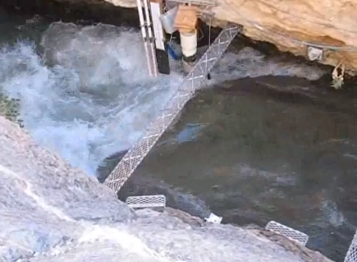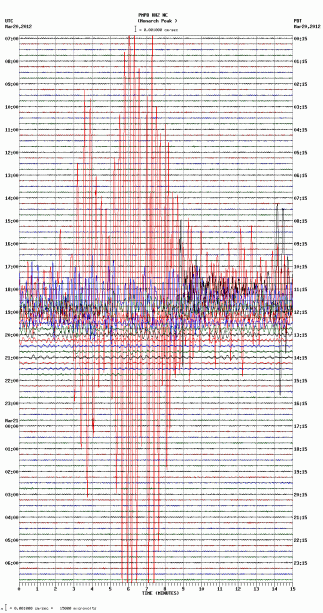On Friday, February 10, the journal Science published our paper on deformation caused by the M7.2 El Mayor-Cucapah (EMC) earthquake of April 4, 2010. The data we present is the first of its kind at this scale and scope: we have both pre-earthquake and post-earthquake high resolution topographic surveys that cover virtually the entire fault rupture, all 120 km of it. We used both to calculate the topographic change resulting from this large temblor, and present the results in this paper.

The widely publicized oblique view of the post-earthquake topography is colored by direction and amount of vertical motion caused by the earthquake. Blue is down, and red is up. Gradations from light to dark blue represent sagging and warping of the ground, distributed deformation that is not evident without a comparison to pre-quake topography. My field photo at right shows a ground-level view of the same scene. The fault ruptures are prominent, but subtle warping of the ground is difficult or impossible to see.
The bottom line: earthquakes distort the surrounding volume of rock in complex ways that extend beyond our simpler models of fault slip, and understanding the mechanisms that cause faults to slip they way they do requires detailed documentation of this coseismic deformation field. That is to say, high-resolution topographic surveys (in addition to GPS measurements and remote sensing–e.g., satellite imaging–analysis) allow us to see how faults slip during earthquakes, and how they may do so in the future, crucially identifying things like how they may link together to generate larger earthquakes.
As a Science article, this project generated a lot of media attention, and there are plenty of news pieces on it suitable for the lay reader. These generally communicate the broad gist and social importance of the research, but they understandably leave out a lot of the scientifically relevant nuance of our results. “3D Laser Map Shows Before-and-After of an Earthquake” explains what we did and that it’s cool, but it doesn’t address how what we did tells us anything or why it’s cool. Below is a sample of news blurbs about the paper for your basic summary:
UC Davis press release, NASA homepage, Scientific American, Popular Science, Science Magazine Online, The Daily Mail, The Huffington Post, Our Amazing Planet, Gizmodo
For those of you with true scientific interest in the process of earthquake rupture and its effect on landscapes, I recommend actually reading the article.
“Near-Field Deformation of the El Mayor-Cucapah Earthquake Revealed by Differential LiDAR” – Science
Here’s my somewhere-between-basic-and-technical summary of the findings presented in this paper.

Airborne Laser Swath Mapping is accomplished by recording laser pulses reflected off the ground on a sensitive, GPS and gyroscopically oriented instrument mounted on a plane. Rapid measurements (tens to hundreds of thousands of points per second) allow comprehensive and detailed representation of the ground surface and features on it as a geolocated cloud of points in 3D space.
First of all, we used LiDAR, which stands for “light detection and ranging” and is accomplished by shooting laser pulses at known orientations to ascertain the distance to solid objects, like for instance the ground.
Immediately after the EMC earthquake, a team of scientists with direct and immediate interest in the quake took a helicopter flight over the epicentral region to try and identify which fault had ruptured to cause the temblor. Their aerial reconnaissance identified several major surface breaks along the causative faults of this earthquake, helping pin down the extent of the rupture. Their initial maps were supplemented with satellite-based identification of fault slip in which comparisons of pre- and post-event satellite images revealed major shifts of the ground in opposite directions across the Sierra Cucapah and in the Colorado River Delta. My PhD adviser, Michael Oskin, and colleague Ramon Arrowsmith at Arizona State University leapt at the opportunity to exploit LiDAR to study this earthquake. They appealed to the National Science Foundation for rapid funding of an aerial survey of the rupture zone, and enlisted graduate students (like moi) to compile incoming data on the precise location of fault surface rupture and define the extent of the survey we needed.
Getting funding and permission for an airplane to make low, repeat passes collecting high-resolution 3D scans over another country is a logistical nightmare.
Generous and enthusiastic collaboration between Mexican and U.S. researchers and government agencies provided a crucial bridge to move forward with the project, and in August, four months after the earthquake, a plane mounted with a laser scanner was taking off from the U.S. to scan the rupture zone.
Of course on top of international permissions, there are physical logistics to a mid-summer plane flight over the Sonoran desert, and the mission had a few false starts due to surprising cloudbursts.

A mid-summer desert downburst chases the survey plane back up to the U.S. for the afternoon. Sand particles and laser range-finding don't mix. Juan Carlos Fernández Díaz of the National Center for Airborne Laser Mapping took this photo as they retreated from the day's flight.
The resulting dataset is the largest and highest resolution survey of a large earthquake surface rupture scientists have yet obtained. The raw data and various displayable products (including Google Earth files that I encourage everyone to explore!) are available at OpenTopography.com.
The additional key here is that in 2006, the Mexican Instituto Nacional de Estadística y Geografía (INEGI) had conducted a broad, moderate resolution LiDAR survey of the area around the EMC rupture. This meant that we could measure not only the obvious surface breaks evident in the post-event surveys, but the warping and tilting of the ground that would have been invisible to us without some information about its geometry before being disrupted by the earthquake. So voilà! Both pieces came together and we could easily calculate the coseismic vertical displacement of every 5 x 5 meter patch of ground in a 372 sq km swath around the fault rupture.
The data showed not only the expected vertical displacements across obvious vertical escarpments, but revealed broad bending and warping structures adjacent to and between the main faults. This warping was apparently occurring in the rock mass around the faults, and not along structures that slipped during the earthquake.

Obvious vertical escarpment, along a structure that slipped during the earthquake: the Borrego Fault.
A partial explanation for this observation is the transfer of slip from one fault segment to another. Fault slip in the earthquake should broadly represent a big linear tear in the crust, generating a lobate zone of warped ground where elastic strain that built up before the earthquake was released. However, where the causative fault is discontinuous, slip on one of its segments must decrease to zero and be picked up by the next segment some distance away. This creates a zone of crust that isn’t broken by discrete faults, but has to flex in such a way as to transfer all the slip from one fault across to the other. It is these zones in which we see very high strains, which is unsurprising. We also see high strains leading away from the faults, where the ground has “sagged” and bent downward in a more complex response to slip on geometrically irregular structures below. The bottom line is that the observed flexing is bordering on extreme for the rock here, and we posit that it’s likely that it can’t stay this way without failing. Because we don’t see observable faults (in the LiDAR nor on the ground) that account for this warping, we infer that if these strains do indeed exceed the strength of the rock–that is if they surpass the maximum amount the rock can bend–then they are being accommodated by distributed yielding: permanent, subtle deformation of the rock volume. To make a colloquial analogy, it’s like when your mother would tell you that contorting your face too much would make it get stuck that way. Well that’s what may be happening to these rocks.
That’s where the paper gets speculative, because we don’t know that the strain is high enough to make the rock fail that way and become permanently deformed in this case… all we know is that the strains are that high, and that in cases of other earthquakes, elastic deformation has turned into permanent deformation at strains around this magnitude. In any case, it’s indisputable that a great deal of deformation is happening in the volume of rock surrounding the faults, and not simply on the faults themselves. That’s troubling for people like me who also study ancient past earthquakes, because we’re generally only left with what we can observe on the discrete faults themselves. Subtle warping is difficult to detect in the field, and nearly impossible without precise knowledge of the pre-warping geometry. This may have a huge impact on the assessment of the potential sizes of earthquakes a fault system is capable of producing. By hiding deformation from observable structures, off-fault deformation may lead us to underestimate the size of past earthquakes, and thus to underestimate the hazard for a region.
These results also demonstrate that faults can link together to produce bigger earthquakes than we expect. This is something we have observed for a few decades now, in recent earthquakes like the 1992 Landers, CA M7.3 and the 2008 Wenchuan, China M7.9 just to name a couple. Our new LiDAR dataset adds to the evidence we have of faults linking together, and shows us precisely how they do so by capturing the warping of the ground in between them.
Despite this rupture’s length and overall linearity, it occurred as a compound event resulting from slip on as many as five separate but related fault systems, linked together by zones of severe warping. The deformation field revealed from these before and after surveys underscores the ability of faults to link together and thus highlights the importance of small faults away from a main plate boundary in the seismic hazard of a region. When datasets like this reveal the mechanisms underlying surface faulting they help us understand how fault slip happens and what its effects are on the landscape. With every new earthquake we know more in advance of the next quake. California is primed to produce a wealth of information from its next large earthquakes, because “before” LiDAR surveys have been flown of nearly all of its major faults (literally starting with the B4 data set). The state is like one big earthquake trap, waiting to record precisely what happens along faults in the next major temblor. I’m privileged to have gotten to work on this earthquake that set the stage.
 Big quakes in the past week
Big quakes in the past week